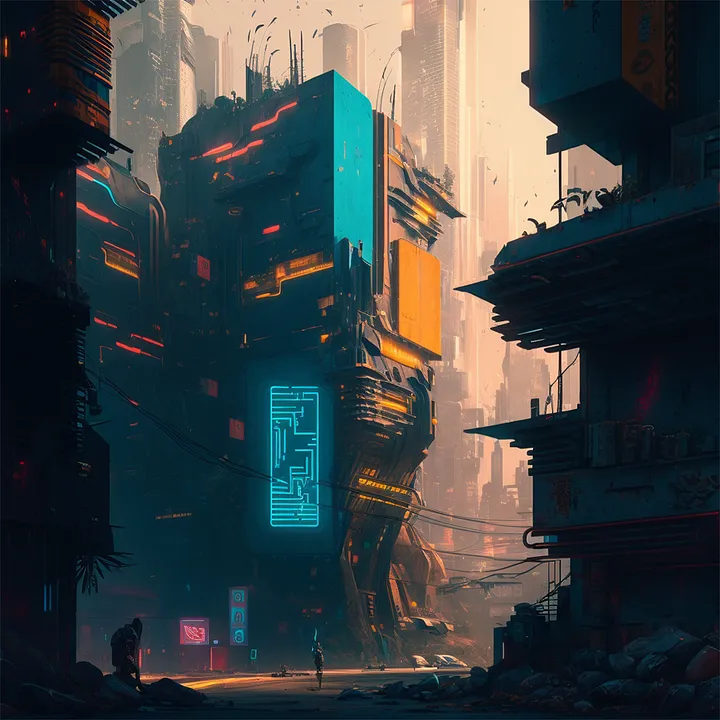OPINION
Generative AI: The Future of Artificial Intelligence (AI)
Creating the Future: What is Generative AI, and How Generative AI is Set to Revolutionize Industries and Transform Society
TL;DR
This article explores generative AI and provides an overview of its capabilities and applications. Generative AI involves the use of neural networks to create new content such as images, videos, or text. Its ability to create realistic and novel content has promising applications in fields such as entertainment, design, and medicine. It also raises ethical concerns around issues such as bias and the potential misuse of generated content.
Disclaimer: This article uses Cohere for text generation.
Generative AI is a fascinating field that has gained a lot of attention in recent years. It involves using machine learning algorithms to generate new data based on existing data. This technology has the potential to transform a wide range of industries, including healthcare, finance, and entertainment. In this article, we will explore what generative AI is, how it is being used today, and what the future holds for this exciting field.
What is Generative AI?
Generative AI is a subset of artificial intelligence (AI) that involves using algorithms to create new data. This can include anything from generating new images and videos to creating new text or music. The key difference between generative AI and other types of AI is that generative AI is focused on the creation of new data, rather than simply analyzing or processing existing data.
Generative AI works by training algorithms on large datasets, which the algorithm can then use to generate new data. For example, a generative AI algorithm could be trained on a large dataset of images, and then use that training to create new, never-before-seen images. This approach has been used to create some incredible works of art, as well as some impressive technological innovations.
How is Generative AI Being Used Today?
Generative AI is being used in a wide range of industries today, from entertainment to healthcare. One of the most notable applications of generative AI is in the field of art, where it is being used to create stunning works of art that would be impossible for a human artist to create. In addition, generative AI is being used to create new music and even entire films.
Another exciting application of generative AI is in the field of healthcare. Generative AI algorithms can be used to create new drugs, based on existing drugs or other data. This approach has the potential to revolutionize the field of medicine, allowing researchers to discover new treatments and cures faster than ever before.
In the finance industry, generative AI is being used to create new financial models and trading algorithms. These algorithms can help traders and investors make more informed decisions, based on a wider range of data. This has the potential to make the financial markets more efficient and more profitable for everyone.
What Are the Best Platforms for Generative AI Nowadays?
Cohere and OpenAI are two of the most widely used tools and platforms for generative AI. Cohere, a startup that specializes in natural language processing, has developed a reputation for creating sophisticated applications that can generate natural language with great accuracy. Their technology has been used to create chatbots, automated content generation, and many other natural language processing applications.
OpenAI, on the other hand, is an AI research laboratory that was founded in 2015. The organization is dedicated to developing AI technologies that are safe and beneficial for society, with a particular focus on generative AI. OpenAI has created several tools for generative AI, including GPT-3, a powerful autoregressive language model that has received a great deal of attention for its ability to generate coherent and natural-sounding text.
Both Cohere and OpenAI have made significant contributions to the field of generative AI, and their platforms and tools are widely used by researchers, developers, and organizations around the world. With the continued growth and development of generative AI, it is likely that we will see even more innovative tools and platforms emerging in the years to come.

How to Get Started With Generative AI?
Getting started with generative AI can be a daunting task, but it is not as difficult as you might think. The first step is to learn the basics of machine learning and deep learning, which are the technologies that underpin generative AI. There are many resources available online, including free courses and tutorials.
Once you have a basic understanding of machine learning, you can start exploring generative AI by experimenting with different algorithms and datasets. There are many open-source libraries and tools available that can help you get started, including Cohere, OpenAI, or <AI2Labs.
What Is the Future of Generative AI?
Looking ahead, the future of generative AI is undoubtedly bright. As technology continues to evolve, we can expect to see even more advanced and sophisticated applications emerging in a wide range of industries.
One of the most exciting prospects for the future of generative AI is the development of even more powerful algorithms that are capable of generating more complex and nuanced outputs. This could include everything from virtual reality environments to music and art, and it has the potential to transform the way we experience and interact with technology.
Another important trend to watch in the future of generative AI is the growing focus on ethical and responsible AI development. With the potential of AI to impact society in profound ways, it is crucial that we take a responsible approach to its development and use. This includes ensuring that AI is used in ways that benefit society, and that it is designed to be transparent and explainable.
Overall, there is no doubt that generative AI will play an increasingly important role in shaping the future of technology and society. As more researchers and developers continue to explore this field, we can expect to see even more exciting and innovative applications emerging in the years to come.

How Will Generative AI Affect the Enterprise and Business?
Generative AI has the potential to revolutionize the way that businesses operate and interact with their customers. One of the most significant impacts of generative AI on enterprises is likely to be in the area of customer experience. With the ability to generate highly personalized and context-specific content, generative AI can help businesses to better engage with their customers and provide a more tailored experience.
For example, generative AI tools can be used to create highly customized chatbots that can provide real-time customer support and assistance. This could be particularly beneficial for businesses that operate in industries where customer service is a key differentiator, such as healthcare or finance.
Generative AI can also be used to automate a wide range of tasks, from content generation to fraud detection. By leveraging the power of machine learning and deep learning algorithms, businesses can automate many of the routine and time-consuming tasks that are involved in running a business. This can help to reduce costs, improve efficiency, and free up employees to focus on more strategic and high-value activities.
Overall, there is no doubt that generative AI will play an increasingly important role in the enterprise and business world. As more businesses start to adopt these technologies, we can expect to see even more innovative and creative ways of using generative AI to transform the way we work and interact with customers.
How to Take Advantage of Generative AI?
Taking advantage of generative AI requires a deep understanding of the technology and its potential applications. The first step is to start learning the basics of machine learning and deep learning, which are the technologies that underpin generative AI. There are many online resources available, including free courses and tutorials that can help you get started.
Once you have a basic understanding of machine learning, the next step is to start exploring the different types of generative AI algorithms and tools that are available. Some of the most popular platforms include Cohere, OpenAI, among others. These tools can be used to develop a wide range of applications, from natural language processing to music and art generation.
Another key factor in taking advantage of generative AI is to identify areas in your business or industry where this technology can be used to improve operations and outcomes. For example, generative AI can be used to automate routine tasks, generate personalized content, and improve customer experience. By identifying the specific areas where generative AI can provide the most value, you can focus your efforts on developing and implementing the right solutions.
Overall, taking advantage of generative AI requires a combination of technical expertise and a deep understanding of the potential applications. By investing in education and training, exploring the available tools and algorithms, and identifying the specific areas where this technology can be most beneficial, businesses can start to realize the full potential of generative AI.
What Can You Create With Generative AI?
The possibilities for what you can create with generative AI are virtually endless. One of the most exciting aspects of this technology is the ability to create completely new and innovative applications that were previously impossible. One of the most popular applications of generative AI is in the field of natural language processing, where it can be used to generate highly realistic and context-specific text.
In addition to natural language processing, generative AI can also be used to create a wide range of visual and audio content. For example, it can be used to generate images and videos, or to create music and sound effects. This has significant implications for the entertainment industry, where generative AI can be used to create new and unique content that is tailored to the individual preferences of each user.
Another area where generative AI is being used is in the field of design and creativity. For example, it can be used to generate unique and creative designs for everything from clothing to architecture. This has the potential to revolutionize the design industry by allowing designers to explore new and innovative ideas that were previously impossible.
Overall, the potential applications of generative AI are limited only by the imagination of the developer. Whether it is creating new types of content, automating routine tasks, or generating new and innovative ideas, generative AI has the potential to transform virtually every industry and aspect of our lives.
Generative AI Business Use Cases
Generative AI is set to play a pivotal role in the future of artificial intelligence. With its ability to create new and unique content, it has the potential to unlock a new level of creativity and innovation in various fields, such as entertainment, marketing, design, and even medicine.
One of the most significant impacts of generative AI is in content creation. This technology can generate a vast array of content, from realistic images and videos to entire text documents. With generative AI, it is now possible to generate large volumes of content quickly and efficiently, providing businesses and individuals with new opportunities to create and share compelling content.
Moreover, generative AI can help businesses optimize their operations by creating more efficient and cost-effective processes. For instance, it can generate synthetic data sets that can be used to train machine learning models, saving companies both time and money in the data collection process.
Another area where generative AI is likely to have a significant impact is in the development of new AI algorithms and architectures. By using generative AI to explore new and innovative ideas, researchers can accelerate the development of new AI technologies and unlock new applications that were previously impossible.
In summary, generative AI is set to revolutionize the way we work, play, and live. Its ability to create new and unique content, optimize business operations, and accelerate the development of new AI technologies makes it a vital component of the future of artificial intelligence.

How Will Generative AI Impact Society?
Generative AI is set to have a profound impact on society, and we’re only starting to scratch the surface of its potential. One of the most significant ways it will impact society is by transforming the way we consume and create content. With generative AI, we’ll be able to produce vast amounts of creative and engaging content, such as images, videos, and even entire pieces of text, at a speed and scale that was once unimaginable.
Moreover, generative AI has the potential to democratize content creation, making it accessible to people who may not have had access to the necessary tools or resources in the past. By reducing barriers to entry, generative AI could empower creators from diverse backgrounds and perspectives to contribute to the cultural landscape in ways that were previously impossible.
Furthermore, generative AI has the potential to help us tackle some of the most pressing issues facing our society. For instance, it could help scientists and researchers develop new drugs and treatments by simulating the behavior of molecules and proteins. It could also help us create more accurate climate models and better understand the impact of human activities on the environment.
Overall, the impact of generative AI on society is likely to be immense. Its ability to transform content creation, democratize creativity, and solve complex problems makes it a powerful tool for shaping the future. However, we must also be mindful of the potential risks and challenges associated with this technology and work to address them proactively.
Final Thoughts
Generative AI is a fascinating field that has already shown its potential to transform various industries, from entertainment and finance to healthcare. With the continued growth and development of generative AI, we can expect to see even more innovative tools and platforms emerging in the years to come.
One of the most exciting prospects for the future of generative AI is the development of even more powerful algorithms that are capable of generating more complex and nuanced outputs. This has the potential to transform the way we experience and interact with technology. Another important trend to watch in the future of generative AI is the growing focus on ethical and responsible AI development.
Generative AI has the potential to revolutionize the way businesses operate and interact with their customers. With the ability to generate highly personalized and context-specific content, generative AI can help businesses to better engage with their customers and provide a more tailored experience.
As more researchers and developers continue to explore this field, we can expect to see even more exciting and innovative applications emerging in the years to come. The future of generative AI is undoubtedly bright, and it will play an increasingly important role in shaping the future of technology and society. So, get ready for a world where generative AI will transform the way we live and work!
Follow me on Twitter and LinkedIn for exciting content on generative AI. Check out Generative AI Lab for some experiments. Last but not least, join Learn AI Together by Towards AI and let’s explore the world of AI together.
